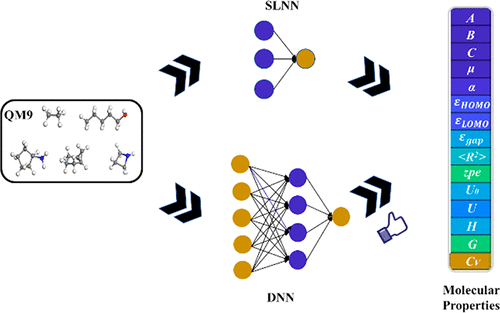当前位置:
X-MOL 学术
›
J. Phys. Chem. A
›
论文详情
Our official English website, www.x-mol.net, welcomes your
feedback! (Note: you will need to create a separate account there.)
Comparison Study on the Prediction of Multiple Molecular Properties by Various Neural Networks
The Journal of Physical Chemistry A ( IF 2.7 ) Pub Date : 2018-10-04 00:00:00 , DOI: 10.1021/acs.jpca.8b09376 Fang Hou 1 , Zhenyao Wu 2 , Zheng Hu 1 , Zhourong Xiao 1 , Li Wang 1, 3 , Xiangwen Zhang 1, 3 , Guozhu Li 1, 3
The Journal of Physical Chemistry A ( IF 2.7 ) Pub Date : 2018-10-04 00:00:00 , DOI: 10.1021/acs.jpca.8b09376 Fang Hou 1 , Zhenyao Wu 2 , Zheng Hu 1 , Zhourong Xiao 1 , Li Wang 1, 3 , Xiangwen Zhang 1, 3 , Guozhu Li 1, 3
Affiliation

|
Various neural networks, including a single layer neural network (SLNN), a deep neural network (DNN) with multilayers, and a convolution neural network (CNN) have been developed and investigated to predict multiple molecular properties simultaneously. The data set of this work contains∼134 kilo molecules and their 15 properties (including rotational constant A, B, and C, dipole moment, isotropic polarizability, energy of HOMO, energy of LUMO, HOMO–LUMO gap energy, electronic spatial extent, zero point vibrational energy, internal energy at 0 K, internal energy at 298.15 K, enthalpy at 298.15 K, free energy at 298.15 K, and heat capacity at 298.15 K) at the hybrid density functional theory (DFT) level from the QM9 database. Coulomb matrix (CM) converted from the database representing every molecule uniquely and its eigenvalue are respectively used as the input of machine learning. The accuracies of predictions have been compared among SLNN, DNN and CNN by analyzing their mean absolute errors (MAEs). Using eigenvalues as input, both SLNN and DNN can give higher accuracy for the prediction of specific energy properties (U0, U, H, and G). For the prediction of all 15 molecular properties at a time, DNN with a 3-layers network exhibits the best results using the full CM as input. The number of layers in DNN play a key role in the prediction of multiple molecular properties simultaneously. This work may provide possibility and guidance for the selection of different neural networks and input data forms for prediction and validation of multiple parameters according to different needs.
中文翻译:

多种神经网络对多种分子性质的预测比较研究
已经开发并研究了各种神经网络,包括单层神经网络(SLNN),具有多层的深度神经网络(DNN)和卷积神经网络(CNN),以同时预测多种分子特性。该工作的数据集包含约134千个分子及其15个属性(包括旋转常数A,B和C,偶极矩,各向同性极化率,HOMO能量,LUMO能量,HOMO–LUMO间隙能量,电子空间范围,零点振动能,0 K时的内能,298.15 K时的内能,298.15 K时的焓,298 kW时的自由能QM9数据库中的混合密度泛函理论(DFT)级别的热容量为298.15 K,热容量为298.15 K)。从数据库中唯一表示每个分子的库仑矩阵(CM)及其特征值分别用作机器学习的输入。通过分析SLNN,DNN和CNN的平均绝对误差(MAE),比较了预测的准确性。使用特征值作为输入,SLNN和DNN都可以为特定能量属性(U 0,U,H和G)。为了一次预测所有15种分子特性,使用3层网络的DNN使用完整的CM作为输入时表现出最好的结果。DNN中的层数在同时预测多种分子特性中起着关键作用。这项工作可以为选择不同的神经网络和输入数据形式,以根据不同需求预测和验证多个参数提供可能性和指导。
更新日期:2018-10-04
中文翻译:

多种神经网络对多种分子性质的预测比较研究
已经开发并研究了各种神经网络,包括单层神经网络(SLNN),具有多层的深度神经网络(DNN)和卷积神经网络(CNN),以同时预测多种分子特性。该工作的数据集包含约134千个分子及其15个属性(包括旋转常数A,B和C,偶极矩,各向同性极化率,HOMO能量,LUMO能量,HOMO–LUMO间隙能量,电子空间范围,零点振动能,0 K时的内能,298.15 K时的内能,298.15 K时的焓,298 kW时的自由能QM9数据库中的混合密度泛函理论(DFT)级别的热容量为298.15 K,热容量为298.15 K)。从数据库中唯一表示每个分子的库仑矩阵(CM)及其特征值分别用作机器学习的输入。通过分析SLNN,DNN和CNN的平均绝对误差(MAE),比较了预测的准确性。使用特征值作为输入,SLNN和DNN都可以为特定能量属性(U 0,U,H和G)。为了一次预测所有15种分子特性,使用3层网络的DNN使用完整的CM作为输入时表现出最好的结果。DNN中的层数在同时预测多种分子特性中起着关键作用。这项工作可以为选择不同的神经网络和输入数据形式,以根据不同需求预测和验证多个参数提供可能性和指导。











































 京公网安备 11010802027423号
京公网安备 11010802027423号